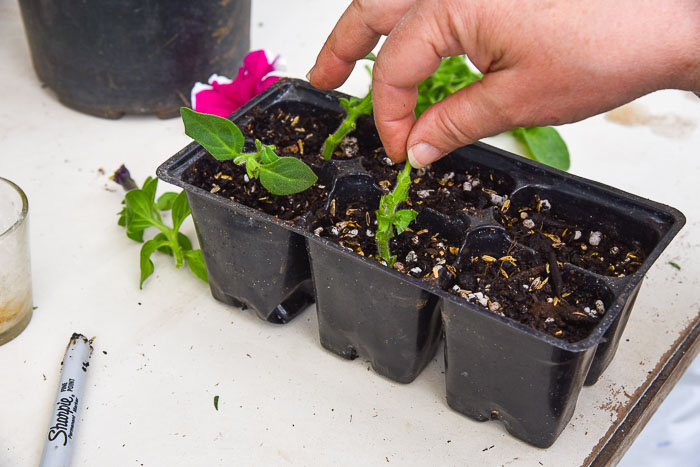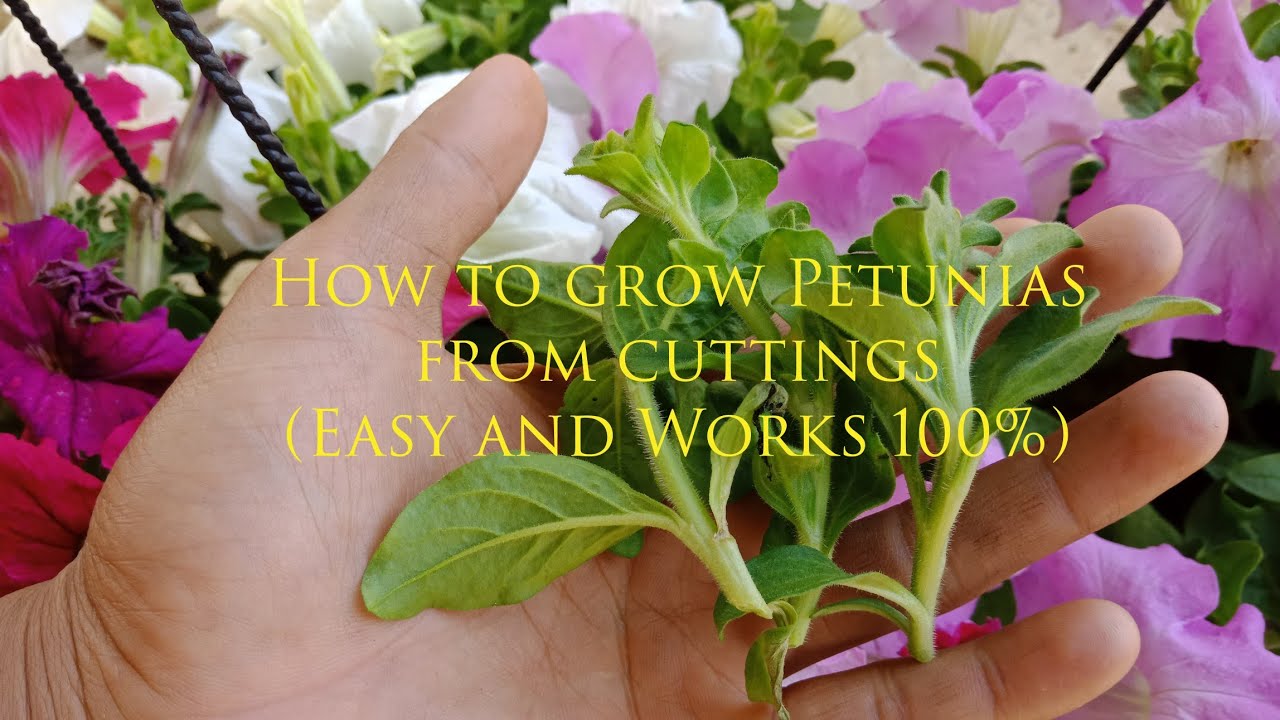To plant petunias from cuttings, prepare a rooting mix and dip the cuttings in a rooting hormone before sticking them in the mix.

Credit: www.flowerpatchfarmhouse.com
Benefits Of Planting Petunias From Cuttings
Planting petunias from cuttings offers several benefits. One of the main advantages is the ability to propagate more plants from existing ones. By taking cuttings from healthy petunias, you can produce multiple new plants, saving both time and money. It is a cost-effective alternative to buying new plants, especially if you have a large garden or want to fill several containers with petunias.
Another benefit is the opportunity to preserve unique varieties. If you have a particular petunia variety that you love, propagating it from cuttings ensures you can continue to enjoy its distinct characteristics year after year. This method allows you to create a collection of petunias with different colors, patterns, and growth habits.
Materials And Tools Needed For Planting Petunias From Cuttings
Planting petunias from cuttings is a simple and cost-effective way to expand your garden. To get started, there are several materials and tools that you’ll need.
| Materials and Tools Needed: |
| Sharp pruning shears |
| Clean pots or containers |
| Fresh potting soil mix |
| Rooting hormone powder (optional) |
| Spray bottle with water |
| Plastic bag or plastic wrap |
Using sharp pruning shears, carefully take cuttings from healthy petunia plants. It is important to use clean pots or containers to prevent any transfer of diseases. Fill the containers with fresh potting soil mix and moisten it using a spray bottle with water. Dip the cut end of the petunia cuttings into a rooting hormone powder (optional) to encourage rooting.
Then, gently insert the cuttings into the soil, ensuring that at least two leaf nodes are below the soil surface. Mist the cuttings with water and cover with a plastic bag or plastic wrap to create a humid environment. Place the containers in a warm and bright location, but avoid direct sunlight. Regularly mist the cuttings to keep the soil moist. After a few weeks, the petunia cuttings should develop roots and can be transplanted into larger pots or directly into your garden.
How to Plant Petunias from Cuttings: Step by Step Guide
Selecting Suitable Petunia Cuttings
To successfully plant petunias from cuttings, it is essential to select suitable and healthy stems. Look for non-flowering stems that are healthy and free from visible diseases or pests. Opt for young and flexible shoots that have the potential to root successfully. Avoid stems that show any signs of diseases or pests, as they may hinder the growth and survival of the cuttings. By carefully selecting the right petunia cuttings, you can increase the chances of successful propagation.
Preparing The Cuttings
When planting petunias from cuttings, it’s important to start with clean pruners to make a 4-6 inch cut below a node. This will ensure that the cutting has the best chance of success. Once the cutting is made, remove the leaves from the lower half of the stem. This will help the cutting focus on root growth rather than supporting the leaves. Optionally, you can dip the cut end into rooting hormone powder.
This can help stimulate root growth and improve the chances of successful propagation. Once the cuttings are prepared, they can be planted in a well-draining potting mix and kept in a warm and sunny location. Regularly water the cuttings to keep the soil moist but not overly wet. With proper care, the petunia cuttings will develop roots and grow into healthy plants.
Preparing The Potting Soil
For successful petunia propagation from cuttings, it’s crucial to ensure that the potting soil is well-draining. Start by filling pots or containers with fresh potting soil, which provides the necessary nutrients for root establishment. Moisten the soil to create a moist but not saturated environment. This ensures proper hydration without drowning the developing roots.
Make sure to avoid overwatering, as excessive moisture can lead to rot and fungal diseases. Additionally, verify that the potting soil allows for sufficient drainage to prevent waterlogging and promote healthy growth. By meeting these preparation requirements, you can create an ideal environment for petunias to root and thrive from cuttings.
Planting The Petunia Cuttings
Planting petunias from cuttings is a simple and effective way to propagate these beautiful flowers. To start, make a hole in the soil using a pencil or your finger. This will create a space for the cutting to be inserted. Next, take a petunia cutting and gently insert it into the hole, making sure that at least one node is below the soil surface.
The nodes are vital for root and stem development. Once the cutting is in place, firmly press the soil around it to secure it in place and provide support. This will help the cutting to establish itself and encourage root growth. Keep the soil moist but not waterlogged, and place the cuttings in a warm and sunny location. With proper care and attention, your petunia cuttings will soon develop into healthy, thriving plants.
Creating A Humid Environment
To successfully plant petunias from cuttings, it is crucial to create a humid environment for the cuttings to thrive. Start by misting the cuttings with water using a spray bottle, ensuring that they are moist but not saturated. This will help to keep the cuttings hydrated and promote healthy root growth.
Covering the pots or containers with a plastic bag or plastic wrap is another effective method to create a mini greenhouse effect. This traps moisture and increases humidity around the cuttings, creating an ideal environment for rooting. However, it is important to ensure that the plastic does not touch the leaves of the cuttings, as this can cause rotting.
Lastly, place the cuttings in a warm, bright location away from direct sunlight. A temperature range of 70-75°F (21-24°C) is ideal for promoting root development. Avoid exposing the cuttings to direct sunlight, as this can cause excessive moisture loss and damage the delicate roots.
Caring For The Cuttings
To successfully plant petunias from cuttings, it is important to provide proper care for the cuttings. One crucial aspect of care is to keep the soil consistently moist without overwatering. This helps to promote healthy root growth in the cuttings.
Additionally, providing indirect light is essential as it encourages the development of roots. To maintain plant health, take the time to remove any yellowing or decaying leaves from the cuttings. By following these care practices, you can increase the chances of successful growth and establishment of new petunia plants from cuttings.
Transplanting The Rooted Cuttings
After 4-6 weeks, check for root growth by gently tugging the cutting. Once roots have developed, transplant the rooted cuttings into larger pots or the garden. Gradually acclimate the transplants to outdoor conditions to avoid transplant shock.
Frequently Asked Questions Of How To Plant Petunias From Cuttings
How Do You Plant Petunias From Cuttings?
To plant petunias from cuttings, start by taking 4-inch stem cuttings from a healthy petunia plant. Remove the lower leaves and dip the cut end in rooting hormone powder. Insert the cutting in moist soil, making sure to keep it well-watered.
Can You Plant Petunias In Pots?
Yes, you can plant petunias in pots. Use a pot with drainage holes and fill it with well-draining potting soil. Plant the petunias, making sure to space them out properly. Place the pot in a sunny location and water regularly.
How Long Does It Take For Petunias To Grow From Cuttings?
Petunias usually take about 2 to 3 weeks to root and start growing to a suitable size for transplanting. Make sure to keep the soil moist and provide them with adequate sunlight during this time.
Conclusion
Planting petunias from cuttings is an easy and cost-effective way to propagate these beautiful flowers. By following the steps outlined in this blog post, you can create a lush and vibrant petunia garden in no time. Remember to choose healthy cuttings, provide adequate sunlight and moisture, and give them time to root before transplanting.
With a little patience and nurturing, you’ll be rewarded with a stunning display of petunias that will bring joy to your garden all season long. Happy planting!

